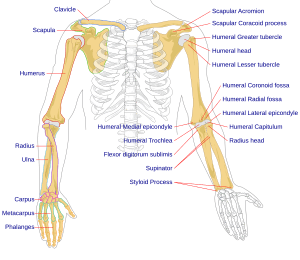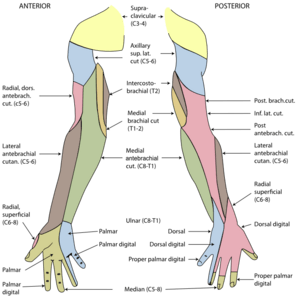Arm facts for kids
An arm is a body part that helps us do many things. Humans usually have two arms, with a hand at the end of each. We use our arms and hands to grab things, lift, and move objects. Some animals, like monkeys, also use their arms to swing through trees or walk on the ground.
Contents
Arm Anatomy: What's Inside?
Bones of the Arm
Your arm has three main long bones. The humerus is the big bone in your upper arm. It connects to your shoulder blade (scapula) at your shoulder.
At your elbow, the humerus connects to two bones in your forearm: the ulna and the radius. The elbow is a hinge joint, which means it lets your arm bend and straighten like a door hinge. The humerus is a very strong bone, able to handle a lot of weight.
Muscles of the Arm
Your arm has different groups of muscles that help it move. These muscles are separated into two main areas: the front (anterior) and the back (posterior). Each area has muscles that work together and are controlled by the same nerves.
Here are some important muscles in or near your arm:
- The deltoid muscle is a large muscle that covers your shoulder. It helps you lift your arm away from your body.
- The brachioradialis muscle starts in your arm but goes down into your forearm. It helps you turn your hand so your palm faces forward.
Nerves of the Arm
Nerves are like tiny wires that send messages between your brain and your muscles. They tell your muscles when to move and help you feel things.
The musculocutaneous nerve helps control the muscles in the front of your arm, like your biceps. It helps you bend your elbow.
The radial nerve controls muscles in the back of your arm, like your triceps. It helps you straighten your elbow and wrist. This nerve runs very close to the humerus bone. If the humerus bone breaks, it can sometimes affect this nerve.
Other nerves, like the median nerve and the ulnar nerve, also pass through your arm. They don't control arm muscles directly but continue into your forearm and hand. The ulnar nerve passes behind your elbow's inner bump. This is the nerve you hit when you feel a "funny bone" sensation!
See Also
Images for kids
-
The arm, as can be seen here, formed one component of hieroglyphs






